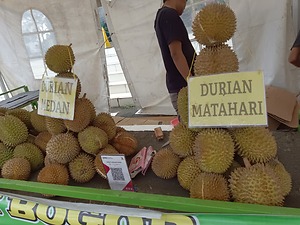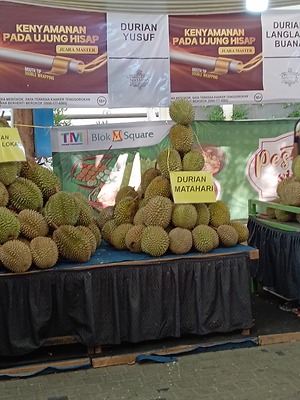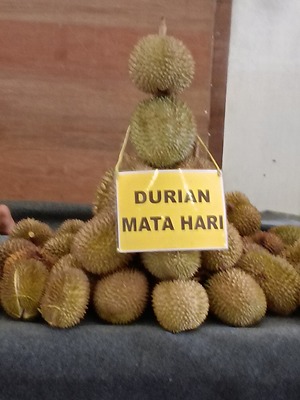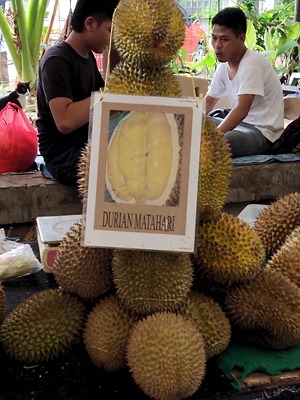


Matahari Durian
Estimated Inventory, lb : 0
Description/Taste
Matahari durians are medium to large fruits, averaging 2 to 4 kilograms, and generally have an oval to elliptical shape. The surface is covered in large, pyramidal spikes that are widely spaced, pointed, sharp, and slightly crooked, and the spikes range in variegated hues of green and brown. Underneath the surface, the husk can be cut and torn open along vertical seams to reveal a white, spongy interior with a unique light pink center, encasing multiple thick lobes of flesh nestled in elongated chambers. Each bright yellow lobe has a slightly wrinkled appearance, containing soft, fatty, and sticky flesh that becomes crunchy and firm closer to the seed. There is also a round to oval, large brown seed found in the lobes, and the size and shape of the seed will vary depending on the individual fruit. Matahari durians emit a mild scent, considered less pungent than other durian varieties, and have a rich, sweet flavor with a smooth, fiberless texture.
Seasons/Availability
Matahari durians are available during Indonesia’s wet season, a period generally spanning from October to April.
Current Facts
Matahari durians, botanically classified as Durio zibethinus, are a popular Indonesian variety belonging to the Malvaceae family. The name Matahari roughly translates from Indonesian to mean “sun durian” and is a descriptor given for the fruit’s bright yellow, sunshine flesh. Matahari durians have a mild, less potent aroma than the other well-known Indonesian variety, petruk durian, and the trees are resistant to root rot and other diseases, allowing farmers to grow the variety in wet, warm climates. The trees also begin to bear fruit in 5 to 6 years, earlier than other durian varieties, and continue to produce 50 to 200 fruits annually, even during old age. Matahari durians are considered one of Indonesia’s most promising local cultivars, selected to compete with the Thai monthong and Malaysian musang king durians. The sweet-fleshed variety is slowly expanding in cultivation as farmers recognize its agreeable growth characteristics, but production is still relatively low, reserving many of the fruits to durian enthusiasts searching for luxury cultivars on the island of Java.
Nutritional Value
Matahari durians are an excellent source of vitamin C, an antioxidant that strengthens the immune system, boosts collagen production, and reduces inflammation. The fruits are also a source of calcium to promote strong bones and teeth, potassium to balance fluid levels within the body, fiber to stimulate the digestive tract, and contain lower amounts of folic acid, phosphorus, iron, copper, and zinc.
Applications
Matahari durians have a sweet flavor and soft, thick flesh best suited for fresh eating and as a flavoring for desserts. The fruits can be cut along their seams, torn open, and the flesh can be eaten raw, discarding the thin seeds. Durian seeds are edible once cooked and are traditionally roasted or boiled. Matahari durian flesh can also be blended into smoothies, coffee, or combined into other beverages. In addition to fresh eating, durians are popularly incorporated as flavoring into desserts in Indonesia. The fruits can be used to flavor baked goods, including cakes, rolls, bars, and tarts, or they can be mixed into sop durian, a cold soup made from ice, durian, condensed milk, and grated cheese layered with a variety of sugary toppings. They can also be added to sticky rice, blended into ice cream, paired with shaved ice and syrups, pureed with sprouted coconut into a thick, sweet drink, or submersed in cendol durian, a cold mixture of shaved ice, durian flesh, noodles, sugar, and coconut milk. Matahari durians pair well with coconuts, pandan, melon, apples, pears, whipped cream, chocolate, and vanilla. Whole and fresh, unopened Matahari durians will keep 5 to 6 days after harvest. Once the flesh is removed from the husk, it can be stored in an airtight container for 4 to 5 days.
Ethnic/Cultural Info
Matahari durians are one of the only local Indonesian varieties that has received a certificate of excellence from the Banten Province Seed Certification Supervisory Agency, or BPSB. This certificate acknowledges the variety as a quality durian and encourages farmers to plant the cultivar as a potential income source. Matahari durian trees also develop an extensive root system, preventing the variety from being planted in smaller home gardens. Growers throughout the neighboring provinces of Banten and West Java have established larger durian farms to cultivate the variety and are creating agro-tourism programs as an additional source of income for the farm. Many of the durian farms feature tasting rooms to purchase and sample different durian varieties, and they also provide guided tours on brightly colored trams. Visitors can take photos of the durian trees, and at the Warso Durian Farm in Bogor, there is even a large durian statue, created as a photo stop. At the Inagro Farm in Bogor, visitors can learn about sustainable living and how durian farming provides tools to protect against food insecurity. Matahari durians are also grown at the Mekasari Fruit Garden, a conservation center that promotes the preservation, biodiversity, and continued cultivation of tropical fruits.
Geography/History
Matahari durians were developed through a series of natural crossbreeding techniques used through farms in Bogor, West Java, and were released for cultivation sometime during the 20th century. The sweet, brightly colored fruits were favored for their mild aroma and thick flesh and quickly became a superior local variety. Matahari durians are one of the top Indonesian durian cultivars that have the potential to become a commercial export. Today Matahari durians are still cultivated on a small scale and are grown through select farms in Bogor of West Java and in areas throughout the province of Bentan.
Recipe Ideas
Recipes that include Matahari Durian. One
| What To Cook Today |
|
Durian Cream Puffs |
| Table for 2...or more |
|
Durian Cendol |
| Tastemade |
|
Durian Sop |
| Cuisine Vault |
|
Durian Cake |
| Resepkuerenyah |
|
Durian Ice |











